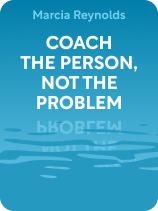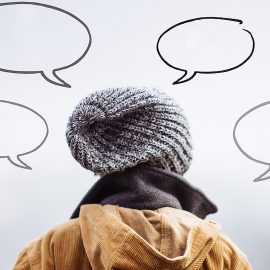

This article is an excerpt from the Shortform book guide to "Coach the Person, Not the Problem" by Marcia Reynolds. Shortform has the world's best summaries and analyses of books you should be reading.
Like this article? Sign up for a free trial here.
What does a life coach do, exactly? What’s their role in helping clients to improve their personal and professional lives?
Marcia Reynolds is a leadership and executive coach who has worked with a range of clients—including corporations like AT&T and American Express, universities, and government agencies. Through her work, she discovered exactly what a life coach does to create lasting change in a client’s life.
Read on to learn what exactly a life coach does, based on Reynolds’s coaching experience.
Marcia Reynolds on Coaching
Marcia Reynolds is a leadership and executive coach who hit rock bottom in a jail cell on drug abuse charges at age 20. Upon release, she began advising people on how to make positive change in their lives, but grew frustrated when she discovered that people easily fall back into old habits. She discovered that lasting change comes only when people confront the underlying assumptions and emotions that have led them into the same, problematic situations time and again. So, what does a life coach do, exactly? In this article, we’ll explain Reynolds’s definition of coaching and the mindsets that clients and coaches need to have a productive working relationship, based on Reynolds’s book Coach the Person, Not the Problem.
What Does a Life Coach Do?
To explain exactly what a life coach does, Reynolds first claims that coaching is a partnership aimed at helping clients root out underlying reasons for why they feel stuck and helping them to move forward in their professional or personal lives. A coach’s role is to support clients in a deep investigative process to identify and challenge assumptions that underlie their beliefs and limit their progress—not be an expert who doles out advice or solves clients’ problems from on high. She says that coaches view clients as capable of making change when given the proper support and tools.
(Shortform note: The coach-client partnership Reynolds recommends is broadly understood as best practice, but some coaches offer more detailed insight than Reynolds into why it can be challenging not to take on a stronger, less balanced role of “guide” with clients: Coaches are trained to take an impartial view of clients’ goals and share insights and observations from a place of non-attachment. This essentially suggests that coaches should have no feeling about whether a client accepts, rejects, or ignores their feedback. But the truth is, coaches are invested in their clients’ well-being and, like all humans, have egos and want to feel validated, so rejection of their feedback can hurt—all of which is a lot to process.)
Note: In Coach the Person, Not the Problem, Reynolds doesn’t specify the type of coaching her book advocates, but her background is in leadership and executive coaching, so we can intuit that her strategies and recommendations are useful for people doing related work.
Required Mindsets for Clients and Coaches
Reynolds argues that coaching should only begin after prospective clients and coaches have established a clear, mutual understanding of the nature of their work together and their respective roles.
Before you begin sessions with a client, ensure that they’re looking for a coach, not some other type of professional or non-professional relationship, for help. You can determine this by asking what kind of support they think will be most helpful to them. If the client indicates that they’re looking for a shoulder to cry on, someone to vent to or fix their problems, or someone who will just listen to them, they’re better off talking with a mentor or a therapist, not a coach. Sometimes clients aren’t exactly sure what a life coach does or can do to help their situation—Reynolds says that clues that clients are looking for a coach include their saying that they need help making a decision or moving forward in a situation, but feel overwhelmed, don’t know all their options or which steps to take first, or fear they’ll make a bad decision.
Once you’ve determined that a client wants a coach, assess your readiness to coach them. You’ll know you’re ready when you:
- Believe the client has the basic skills and ability to self-reflect and choose the best path forward when provided support
- Feel you can partner with them to help them identify and achieve their goals without imposing a specific agenda on their behalf
- Want them to succeed
| How Clients Can Make the Most of Coaching Others agree with Reynolds’s assertion that coaches and clients have to be on the same page about their relationship and respective roles, asserting that if clients are looking for someone to listen to their problems and examine their feelings, they should go to a therapist instead of a coach. This is why it’s important to clarify exactly what a life coach does before beginning coaching sessions. They should also hold onto their money and avoid coaches if they: – Are looking for specific technical training that’s better found with a teacher or trainer who has expertise in their area of interest – Think that coaches will make their problems disappear overnight – Feel that a prospective coach isn’t truly invested in their success Once a client has decided that they want to be coached, they can make the most of sessions by spending five-to-10 minutes preparing for each meeting. This should include asking themselves questions such as: “How am I feeling right now?” What is and isn’t working well?” and “What do I want to achieve in this session?” Collecting their thoughts in advance will prevent them from drifting through sessions without a clear focus. Clients should also enter each session committed to making the most of it. This means showing up to each session they’ve committed to, not holding anything back, and choosing to go deep into their experience to make the most of it. |
Upon clarifying exactly what a life coach can do to help a client’s situation and determining that you and your client are ready for a coaching relationship, discuss expectations. Clarify that you’re in a partnership where your role is to help them identify and address the root of challenges they face, and their role is to engage openly and wholeheartedly in that process. This will require that they:
- Respond to your reflections and in-depth questioning, even when it’s uncomfortable
- Be honest and explore things they may not currently be aware of or fully understand
- Show up to sessions prepared to work and follow through on actions they’ve committed to taking between sessions
- Set aside time before and after sessions to think about what they want to accomplish, what they’ve learned, and what else they want to know
(Shortform note: After explaining exactly what a life coach does, experts say there are other key expectations you should set with clients from the outset, including how much time a week they can spend with you—particularly if your rates are low. For example, you might only be able to offer 30-minute sessions per week but have unlimited email availability. It can also help to tell clients what to expect if they’re unhappy with your services. For example, you should tell them if you provide refunds or a money back guarantee, and how and in what period of time you make those things available.)

———End of Preview———
Like what you just read? Read the rest of the world's best book summary and analysis of Marcia Reynolds's "Coach the Person, Not the Problem" at Shortform.
Here's what you'll find in our full Coach the Person, Not the Problem summary:
- The mindsets and skills required of clients and coaches to work together effectively
- The four practices coaches should employ to make the most of coaching sessions
- Why the role of a coach is not to fix surface-level problems






